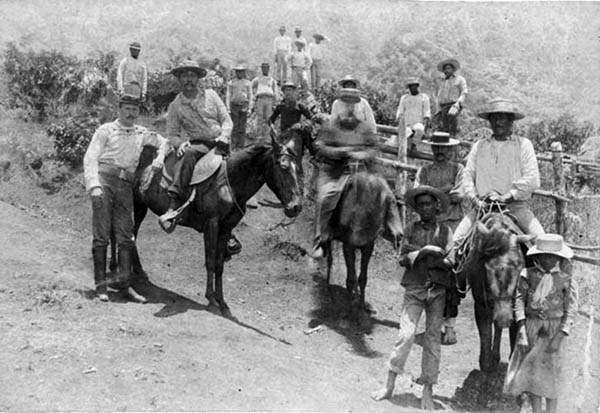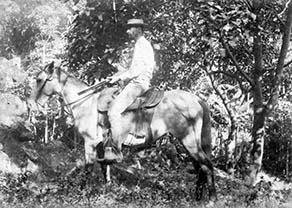 |
 |
 |
|||||
Horseback Rescues
|
|
“I would do any rescue on the trail, anytime, any weather, anyplace on the trail,” Samson states. “On horseback, yeah, that’s my wheels. The horse is everything to me except what he cannot do. What he cannot do is to take care of the person. He does everything else.” “We go rescue night time,” Kelii adds. “Horses—we had unbelievable horses to go into the Nā Pali. My dad was a retired fireman—he’d become a fireman after the original ranch closed down.” 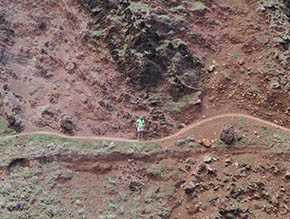
“All kind of weather,” Samson admits. “Whenever you climbing the trail, when you can see the bottom, it’s when you go into the next turn before you go in , zig-zag, so the next turn when you go in after you can see Kē‘ē beach, the next thing when you bend that way, all those ins and outs with the little cliff. When it rains, the water comes, so you got to watch if it falls on the trail. "Then if you get enough room, if you’re right inside that waterfall you safe, so you got to get enough pressure to pick that thing over the trail you can go underneath. Because you don’t want to get we. If you’re walking, you can be warm yourself, but if you don’t, oh, that’s a cold shower! “But that’s why I was able to do all that. Everybody think it’s me. I tried to tell them, ‘No, it’s not me, it’s two of us. That other guy and me. I only do what the horse cannot do. The rest is everything the horse.’ With the horse, you don’t need no nothing for travel. So I can travel anytime of the day and night. Only the flooding, then you got to decide whether you want to take your horse or not. Hanakāpī‘ai, you can cross, no matter how big. But you got to make sure you line up with that rock, right where the normal trail is. Because when it drops—if you lose that, then if the horse loses footing, then you got a big problem. So all you do is you ride your horse. He knows where that trail is, so you take him up stream and then he knows what to do. “I can do it because I got the stuff, and I got the stuff because I always like talk about, I remember that talk about those little Hawaiian ponies, and I’m laughing and I said, “Well I’m going to make these horses, go hunt pig, they do a lot for me. What people don’t know, I use them for rodeo. No problem. I can always use them on the trail. "And then for kids, you can trust them. For me, these guys I know you can trust. Once they hit the trail, they know that trail, they’ll take anybody that will go in. But not anybody can use them because they know who they can fool, who they can harass, so that they don’t have to go. “I used them. They got the stuff. The breed that I had, this would be the last one,” Samson points to the horse behind his home. “The old breed that people on the island love, the breed, they’re strong. They get the last of that breed, but they got different colors because we kind of cross breed. I never had mares.” 
“When we rescue in Kalalau, I had a drowning up stream. So when they call me. ‘Well there’s a rescue in Kalalau.’ Guys go bathe in the river. Nice place. So I go up—just keep on going, because you want to make sure by afternoon we get the body out. If you know the place, then it makes everything easy. If somebody knows the place, you right into that area and in the water. You know, small place, but is it visible or not? And so I thought, ‘Got to be around here.’ Look for the deep place, the deepest place. So went over this big rock—he was there. I said, ‘Lucky the water could move his hair.’ All they could see was his head, just below the water. “Maybe he slipped, hit his head, I don’t know. It’s all that kind of thing. In the pali and the kuahiwi, well, anything can happen. So when you go there you look for safe places! The best, find a place where you can see good, and stay there. You cannot do more than that. You got to have a system for you, so you can function where you’re going to be safe, you just have to. Because you’re by yourself—you and your shadow. And most guys want to go in, not where everybody frequent. You’re on your own. There’s no more room for error, if you want to come home. “Kalalau and Lumaha‘i, the ocean almost the same. Can be flat, and bingo! you know you get one big wave! So you just got to know the places. I know I have some drowning from Waikoko. I saw the call come a long way, something wrong. And that weekend when I went work over here, to go rescue, ‘Oh, two guys missing.’ I just said ‘Oh.’ And then when one of the guys went end up, going to Hanalei past the bridge, came right on the beach over there. It was one of the guys from that truck was of Lumaha‘i. Yeah, the ocean had bring them in here. And the other guy, we never find him. He could have been close within the wave, on the bank, without knowing that place. 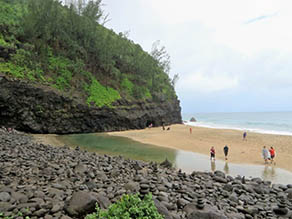
“So any place you go, it’s what you’re doing: check if the wall wet—and only one thing going to make that wet, and that is one big wave. So if you see that and you went below there. But he always had one simple way, if you want to save your life. You don’t know the places, what you got to look for? Look for wave. If you want to stay there, make sure you know how high the wave coming. Otherwise you going to be gone by one simple stuff. "Go any place, you got to make sure—you equip yourself and everything you should know about the area. Or don’t know, just play it safe. Just use that refrain: Play it safe. Or get outta there!” “I think they’re saying that somewhere around 900 to 1,000 people a day use the Kalalau trail,” Ka‘iulani adds. “Which by the way isn’t really a true Hawaiian trail. It was built to catch a. And they don’t take care of the trail at all. There is very little funding spent on maintaining the trail. Lots of people lose their lives there. There is no parking. 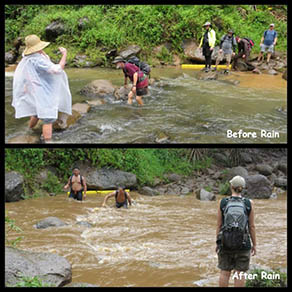
"People go to the State website that talks about the Kalalau Trail, and they get in my car, and I’m looking at them and thinking, “Your butt should not be on that trail.” It is an extremely difficult hike. Ten and a half miles. And I have done a lot of them on this island. I have hiked many, many trails. I didn’t get to Wai‘ale‘ale yet but I have hiked a lot of the very difficult hikes and I have to say, that one takes the cake. “And the first two miles that these people are sold on, ‘Well we’re just going to run into the waterfall.’ It’s an 8 mile round trip, not maintained. You have to cross a very treacherous river, more treacherous than not, with flash flooding. There’s a board where they make the hash marks about how many people have lost their lives crossing that river. "I personally have picked people up whose eyes are big as flying saucers, going ‘Oh my god, we thought we were going to die!’ And still people go, and still the State does not adequately prepare people, nor do they upkeep the trail. Anyone who knows that trail knows it isa very tough hike. In the best of shape you take a beating on that trail.” |
